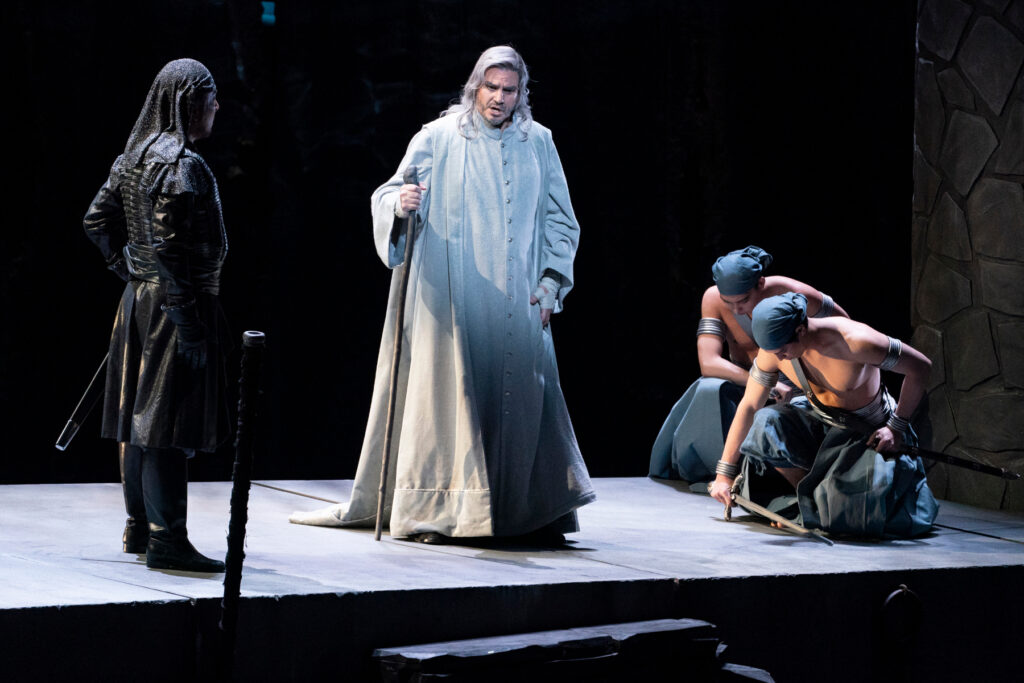David McVicar’s production of Wagner’s Tristan und Isolde, making a welcome return to the New National Theatre, Tokyo, was seen on March 20. The revival, the first since its widely acclaimed premiere in 2010, is in the hands of the conductor Kazushi Ono and the revival director Yasuhiro Miura. The title roles, originally reserved for Torsten Kerl (Tristan) and Eva-Maria Westbroek (Isolde), were taken by Hungarian tenor Zoltán Nyári (house debut) and Latvian soprano Liene Kinča, respectively. This unanticipated substitution brought an almost inevitable consequence: the iconic lovers looked rather tense and restless throughout the performance, not so much star-crossed lovers united in death as struggling professionals keen to fulfil their responsibilities. The audience’s enthusiasm was raised mostly by the superb trio of soloists: the German bass Wilhelm Schwinghammer (König Marke/house debut), the Latvian bass-baritone Eglis Silins (Kurwenal), and the legendary Japanese mezzo Mihoko Fujimura (Brangäne).
McVicar’s emphasis on Nature in this Wagnerian drama was staged with sophistication by Robert Jones. Among the set of natural elements, the moon deserves particular attention. During the yearning prelude, the pale moon – atmospherically lit by Paule Constable – rises slowly, changing its colour to red at the beginning of Act 1. This immense red moon illuminates the boat bound for Cornwall, in which Isolde discloses her secret about Tristan to Brangäne. The moon-turning-red phenomenon is repeated in the final act, where the dying Tristan desperately awaits Isolde on the deserted coast of Brittany.

As a last-minute substitute (announced less than a month prior to the opening night), Zoltán Nyári delivered everything one expects in this sort of situation. The actor-turned-opera singer has a fine, lyrical voice, and sung best in the long duet with Isolde in Act 2. Apparently, he was saving his voice until the last act, in which he sustained his massive monologue with great passion, if not volume. Nyári’s committed performance would have prompted more enthusiastic applause had it been soaked in the deadly eroticism the composer imagined.
Wilhelm Schwinghammer’s König Marke was outstanding. On his entrance in Act 2, he immediately stole the scene with his imposing figure clad in shining silver-grey from top to toe, a wand in his hand reminiscent of Prospero in Shakespeare’s Tempest. From his first line, “Tatest du’s wirklich?” to the last, Schwinghammer’s cavernous, mahogany voice resounded in the auditorium. His dignified, indeed regal, demeanour with his glittering eyes – as if commanding the orchestra from the stage – was electrifying.
As Isolde, Liene Kinča – though blessed with a deep, beautiful voice – regrettably lacked charisma, stamina, and dramatic sense. With Fujimura’s formidably versatile Brangäne beside her, Kinča sometimes looked more like a student than a proud, vengeful Irish princess: “Ich, Isolde!” in the first act lacked the dramatic outburst. Her soaring lines were at times alluring, with her dark, rich voice not unlike Anna Netrebko’s, and she certainly excelled in ringing out the top notes in all acts. Yet the price for this was a lack of legato especially in the descending lines, occasional lapses of pitch, and questionable diction. Her “Liebestod” was powerful enough with the astounding orchestra, yet the overall impression was, with almost no chemistry between the title roles, “Did you really love that man?”

Eglis Silins proved an ardent and loyal Kurwenal. The only cheerful, upbeat character among the serious cast, Silins’s assured Kurwenal, with sonorous voice and immaculate technique, was a delight both for the eyes and ears throughout the show. His “Hei! Unser Held Tristan” in Act 1 was sung in a properly mocking way alongside the acrobatic dance of the half-naked sailors. He was at his best in Act 3, where he serves the dying Tristan with great diligence.
Mihoko Fujimura’s Brangäne was phenomenal. This incomparable Wagnerian mezzo overwhelmed the audience with the warmth and strength of her beautifully controlled voice, her flawless diction and impeccably pitched singing, on top of her skillful conveying of her emotions with her wonderfully flexible facial expressions and nuanced physical movements. Each note was sung with utmost care and love. Her presence-through-absence was most intensively felt in Act 2, where her otherworldly “Einsam wachend in der Nacht” embraced the lovers as well as the whole auditorium. It was a voice that held the audience spellbound.
Of the minor roles, Naoyuki Akitani’s Melot, attired as what looked like a Japanese samurai, served well as a harbinger of König Marke in Act 2. Hideyuki Aochi’s shepherd in Act 3, in turn, appeared in a ninja-like costume, amusing to see alongside the two Celtic men clad in appropriate Medieval outfits. His soft, boyish, almost whispering singing made a stark contrast to his addressee, the strong-voiced Kurwenal.
The lack of intense drama in the title roles was amply compensated by Kazushi Ono and his accomplished Tokyo Metropolitan Symphony Orchestra, proving that in this of all Wagner’s works, the drama lies more in the orchestra than anywhere else. The cellos in the prelude and the cor anglais piping the shepherd’s tune in Act 3 were especially impressive, almost hypnotic. The singing from the male chorus on and off the stage was superb as well.
Natsuko Hirakura
Tristan und Isolde
Music and libretto by Richard Wagner
Tristan – Zoltán Nyári, König Marke – Wilhelm Schwinghammer, Isolde – Liene Kinča, Kurwenal – Eglis Silins, Melot – Naoyuki Akitani, Brangäne – Mihoko Fujimura, Ein Hirt – Hideyuki Aochi, Ein Steuermann – Toshiaki Komada, Stimme eines jungen Seemanns – Kota Murakami
Conductor – Kazushi Ono, Production – David McVicar, Set and Costume Design – Robert Jones, Lighting Design – Paule Constable, Choreographer – Andrew George, Revival Director – Yasuhiro Miura
New National Theatre Chorus, Tokyo Metropolitan Symphony Orchestra
New National Theatre Tokyo, Wednesday 20th March 2024
All photographs © Rikimaru Hotta